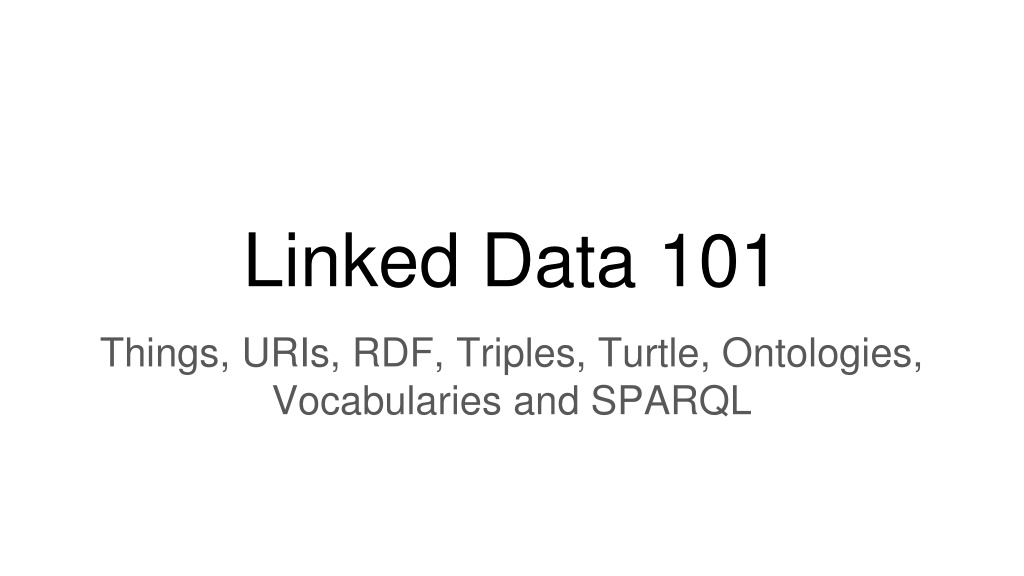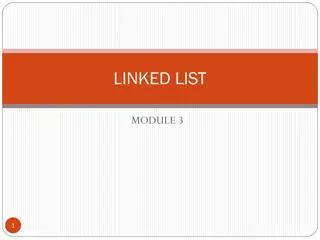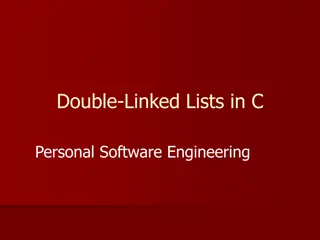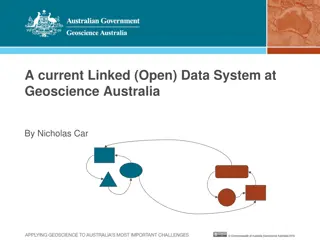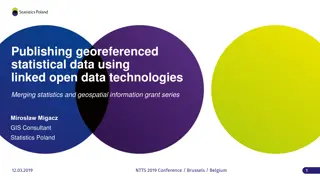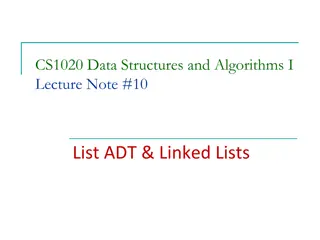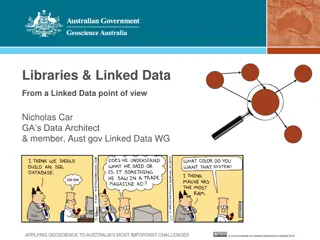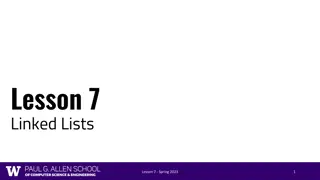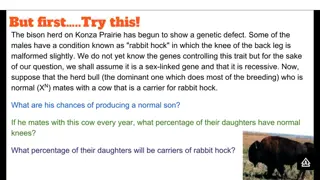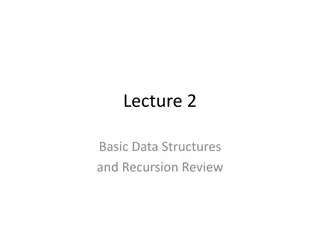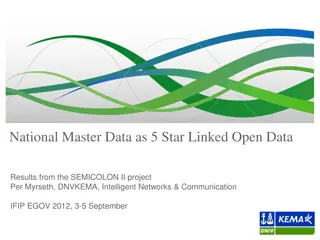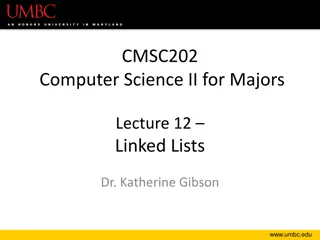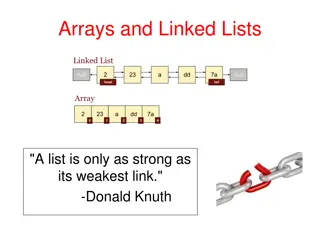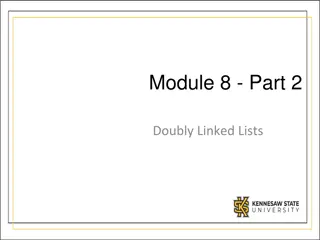Understanding Linked Data: Basics to Publishing and Beyond
Delve into the world of Linked Data with topics ranging from its fundamental principles like URIs, RDF, and Triples to practical aspects like publishing data using standard web technologies such as HTTP. Explore the essence of RDF graphs, the significance of naming things with URLs, and ways to provide valuable information while referencing related entities in the Linked Data ecosystem.
Download Presentation

Please find below an Image/Link to download the presentation.
The content on the website is provided AS IS for your information and personal use only. It may not be sold, licensed, or shared on other websites without obtaining consent from the author. Download presentation by click this link. If you encounter any issues during the download, it is possible that the publisher has removed the file from their server.
E N D
Presentation Transcript
Linked Data 101 Things, URIs, RDF, Triples, Turtle, Ontologies, Vocabularies and SPARQL
What is Linked Data? Tim Berners- Lee 2006 Linked Data is a method of publishing structured data using standard Web technologies such as HTTP, RDF and URIs Linked Data principles: 1.Use URLs to name (identify) things 2.Provide useful information about a thing when it's looked up 3.Refer to other things (using their URL) when publishing data on the Web
What is RDF? The Resource Description Framework (RDF) is a standard model for data interchange on the Web has a relation to Thing 1 Thing 2
Triples In RDF all data is modeled as a triple Predicate Subject Object Triple
Triples In RDF all data is modeled as a triple Resource Resource Predicate (Property) Subject Object Triple (Statement)
RDF graphs Multiple triples form a graph Object Predicate Object / Subject Subject Triple 1
How do I publish my data as Linked Data? 1.Use URLs to name (identify) things 2.Provide useful information about a thing when it's looked up 3.Refer to other things (using their URL) when publishing data on the Web
1.Use URLs to name (identify) things I like pizza
1.Use URLs to name (identify) things like I pizza
1.Use URLs to name (identify) things http://orcid.org/0000-0002-7633-1442 like I pizza
http://www.swoogle.umbc.edu 1.Use URLs to name things Is there already a URL for pizza ? Let s search for it! http://orcid.org/0000-0002-7633-1442 like I pizza
http://www.swoogle.umbc.edu 1.Use URLs to name things Is there already a URL for pizza ? Let s search for it! http://orcid.org/0000-0002-7633-1442 like I pizza http://protege.stanford.edu/ontologies/pizza/pizza.owl#Pizza
1.Use URLs to name things What URL can we use for like ? Swoogle doesn t propose one.. http://orcid.org/0000-0002-7633-1442 like I pizza http://protege.stanford.edu/ontologies/pizza/pizza.owl#Pizza
1.Use URLs to name things Can t find a URL? Create one yourself! http://www.mysite.com/myOntology#like http://orcid.org/0000-0002-7633-1442 like I pizza http://protege.stanford.edu/ontologies/pizza/pizza.owl#Pizza
How do I publish my data as Linked Data? 1.Use URLs to name (identify) things 2.Provide useful information about a thing when it's looked up 3.Refer to other things (using their URL) when publishing data on the Web
2. Provide useful information about a thing when it's looked up What do these URLs resolve to? http://www.mysite.com/myOntology#like http://orcid.org/0000-0002-7633-1442 like I pizza http://protege.stanford.edu/ontologies/pizza/pizza.owl#Pizza
2. Provide useful information about a thing when it's looked up http://protege.stanford.edu/ontologies/pizza/pizza.owl#Pizza You get information about the thing the URL represents (in RDF!) Ontology food subClassOf hasCountryOfOrigin pizza Italy
2. Provide useful information about a thing when it's looked up http://protege.stanford.edu/ontologies/pizza/pizza.owl#Pizza Ontologies typically contain detailed class hierarchy information as well as other relationships of interest to the thing Ontology food http://www.wikidata.org/entity/Q38 subClassOf hasCountryOfOrigin pizza Italy
2. Provide useful information about a thing when it's looked up http://www.wikidata.org/entity/Q38 Vocabularies typically focus on the representation of the thing in different natural languages Italy @ en Itali @ nl prefLabel @ zh @ru Italy Italian Republic @ en altLabel Vocabulary
How do I publish my data as Linked Data? 1.Use URLs to name (identify) things 2.Provide useful information about a thing when it's looked up 3.Refer to other things (using their URL) when publishing data on the Web
3. Refer to other things For example: who do I know? http://orcid.org/0000-0002-7633-1442 like I pizza knows Rajaram http://orcid.org/0000-0002-1215-167X
How to represent RDF? like I pizza <http://orcid.org/0000-0002-7633-1442> <http://www.mysite.com/myOntology#like> <http://protege.stanford.edu/ontologies/pizza/pizza.owl#Pizza>. n-triples
How to represent RDF? like I pizza @prefix orcid: <http://orcid.org/> . @prefix mo: <http://www.mysite.com/myOntology/> . @prefix po: <http://protege.stanford.edu/ontologies/pizza/pizza.owl#> . orcid:0000-0002-7633-1442 mo:like po:Pizza . Turtle
How to represent RDF? like I pizza RDF/XML
How can I query RDF? like I pizza Who does Rajaram know that likes pizza? knows Raja- ram select * where { ?person mo:like po:Pizza . ?person foaf:knows orcid:0000-0002-1215- 167X } SPARQL / Triple Store
How can I query RDF? like I pizza Who does Rajaram know that likes pizza? knows Raja- ram select * where { ?person mo:like po:Pizza ; foaf:knows orcid:0000-0002- 1215-167X } SPARQL / Triple Store
